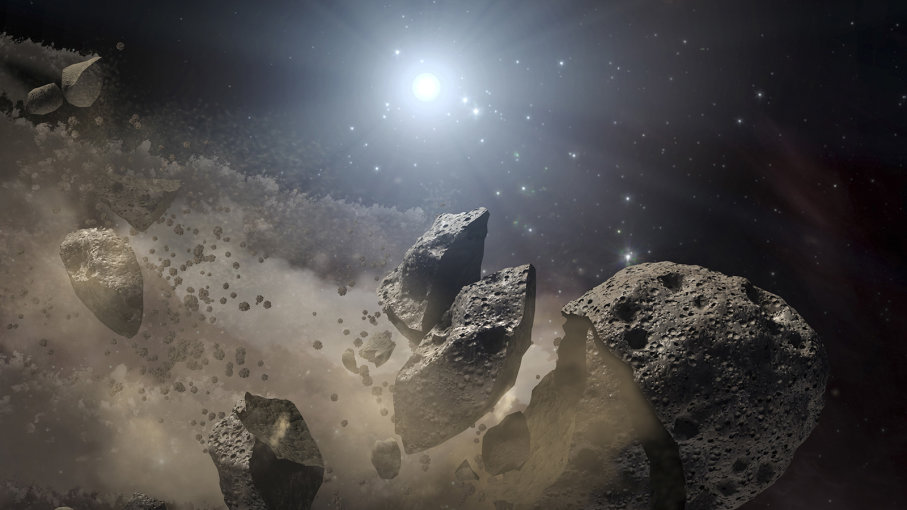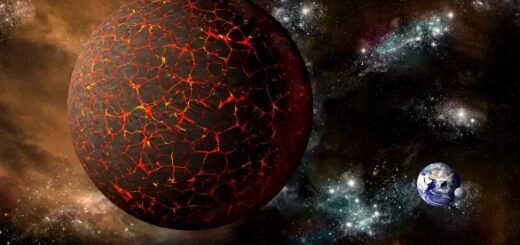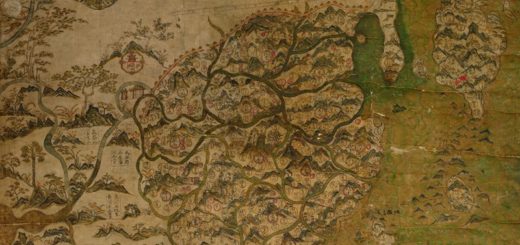White Dwarfs Can Shred Planets to Pieces

This dead star is kept company by a disintegrating asteroid in this artist’s concept. STOCKTREK IMAGES
When our sun runs out of hydrogen fuel in roughly 5 billion years, it will swell into a huge red giant star — violently shedding hot layers of plasma and cooking the inner planets to a crisp. All that will be left behind is an expanding bubble of cooling gas, creating a beautiful planetary nebula and a white dwarf in the middle, shining bright like a stellar diamond. Though we know this is the fate of our nearest star, what of the planets? What will happen to Earth?
Astronomers from the University of Warwick, U.K., took a stab at answering this question and have come up with a rudimentary “survival guide” for planets that find themselves in this grim scenario. While Earth’s fate isn’t necessarily clear, the study, published in the Monthly Notices of the Royal Astronomical Society, has revealed that when it comes to living with a white dwarf star, the tiniest worlds will reign.
Why is that? We know that many white dwarf star systems have quantities of dust surrounding them, and through spectroscopic measurements, dust has been found polluting these stars’ atmospheres. The implication is clear: These star systems used to have rocky planets (plus asteroids and comets) in orbit, but, through extreme tidal interactions with their white dwarf, have been torn to shreds and ground to dust.
Radius of Destruction
So, why do planetary bodies get blended in white dwarf orbit? These exotic stellar objects contain nearly the entire mass of the dead star they came from in a blob of degenerate matter only the size of Earth. With this extreme density comes an incredibly powerful gravitational field and tidal forces. Stray too close to a white dwarf and a planet will experience a more powerful tidal force on the star-facing hemisphere than the hemisphere facing away. Depending on what that planet is made of, at a certain distance — known as the “destruction radius,” demarked by an ominous dusty ring — the tidal shear through the planet will be too much, and it will be literally pulled apart.
To understand where the destruction radius is for a variety of planets of different sizes, the researchers carried out dynamic simulations of different planets in orbit around a sun-like star as it dies and passes through the red giant phase to a white dwarf. This violent phase of a star’s life will disturb the orbit of the planets around it, dragging them to their dusty deaths or even flinging them to wider orbits.
Viscosity Is Everything
Interestingly, the researchers found that it isn’t just the mass and composition of planets that affect how sensitive they are to the tidal shear, it’s their viscosity, or the resistance they have to being deformed. They found that low-viscosity exoplanets — of a similar consistency to Saturn’s moon Enceladus, which is approximately homogeneous — would be dragged to its doom if it resides within five-times its destruction radius from the white dwarf.
At the other extreme, a high-viscosity world could live comfortably if it orbits the white dwarf only twice its destruction orbit. Recently, astronomers discovered a dense “heavy metal” object around a white dwarf that is embedded inside a dusty disk. It’s believed that this object, which isn’t much bigger than a large asteroid, was the metal core of a larger planet that was destroyed by tidal shear, leaving its high-viscosity metallic core behind.
As the search for exoplanets (planets orbiting other stars) becomes more sophisticated, more worlds are going to be seen in white dwarf star systems, so the researchers hope that these simulations will act as a guide that will help us understand what these exoplanets are made of.
But What of Earth?
Although this dynamical simulation has provided some key insights to what it takes to avoid being dragged to a dusty death, it only simulates homogenous objects. When it comes to our planet, the problem becomes more complex.
“Our study, while sophisticated in several respects, only treats homogenous rocky planets that are consistent in their structure throughout,” said lead author Dimitri Veras, in the University of Warwick’s accompanying press release. “A multi-layer planet, like Earth, would be significantly more complicated to calculate but we are investigating the feasibility of doing so too.”
In summary, it pays to be tiny and mighty, composed of heavy metals if you want to have a snug orbit around a white dwarf without being dragged to your death. As for Earth’s fate, we’ll have to wait and see — but in all honesty, you probably wouldn’t want to be here when our red giant sun switches to “broil.”
Learn more about our starry universe in Sara Gillingham’s illustrated guide “Seeing Stars: A Complete Guide to the 88 Constellations.” We at HowStuffWorks choose related titles based on books we think you’ll like and the story you just read. Should you choose to buy one, we’ll receive a portion of the sale.



 Creators of mankind
Creators of mankind Description of “Tall white aliens”
Description of “Tall white aliens” Where they came from?
Where they came from? About hostile civilizations
About hostile civilizations The war for the Earth
The war for the Earth “Tall white aliens” about eternal life
“Tall white aliens” about eternal life Video: “Nordic aliens”
Video: “Nordic aliens” Aliens
Aliens Alien encounters
Alien encounters The aliens base
The aliens base UFO
UFO Technology UFO
Technology UFO Underground civilization
Underground civilization Ancient alien artifacts
Ancient alien artifacts Military and UFO
Military and UFO Mysteries and hypotheses
Mysteries and hypotheses Scientific facts
Scientific facts


















